|
|
| |
| |
 |
Dear Readers,
|
| |
|
It is our pleasure to launch the first issue of OJP4Danube Newsletter. With each new issue, we will try to enhance the exchange of significant information on our common multimodal cross-border trip within the OJP4Danube project.
CONTENTS of OJP4Danube Newsletter#1:
- Welcome from the Lead Partner
- OJP4Danube Project Visual Identity
- OJP4Danube Social Media Channels
- Kick-off Dissemination Event
- First Deliverables and Outputs of WPs
|
|
| |
 |
1. Welcome from the Lead Partner
|
| |
 |
| |
|
Everybody around the globe is speaking about “data as the new oil” as we all hope to get new services and more comfort by using this data for better support services. Same counts for the area of mobility – data is seen as the core element for new and better traveller information services. In parallel, we count on our existing traveller information services, often operated by our regional or national transport operators. These existing traveller information services improve regularly their quality, as real-time updates on interruptions and delays are integrated directly by the responsible operators. But there are limitations, especially in geographical coverage, especially when speaking about cross-border services.
When overcoming the geographical coverage limitation, do I really need to provide data to third parties, or wouldn’t it be smarter to extend the coverage of existing traveller information services by ensuring the known and used quality? Here, OJP4Danube starts by linking existing traveller information services giving the possibility to provide cross-border services even by using existing and proven end-user ones. The cross-border end-user service can be laid out by using the already existing application, the geographical coverage will be extended, and the data quality will remain the same, as still all real-time information will be embedded directly by the operator responsible.
This concept of linking existing services is laid down in the European Delegated Regulation on multimodal traveller information services (2017/1926) and will be piloted with traveller information services focusing on bicycle and rail in the Danube Region by OJP4Danube. The results of the pilot tests will be mirrored again on European level to improve standards and specifications and in parallel contribute to the European policy goals set in the European Green Deal.
1.1. What is Linking Services and OJP?
Linking services is seen as a promising approach to improve the interoperability of systems and thus to create an integrated travel information system. As travel information is often only available locally or in a limited way, "linking services" enables the linking of different local, regional and national travel information systems via a standardised interface (based on the CEN/TS 17118:2017 standard "Open API for distributed journey planning (OJP)"). This virtually links the route INFORMATION (i.e., routing results) for the requested journey (not the data itself) using the route calculation services of the respective local services. Providers thus retain control over the quality, timeliness of data and information content and can continue to guarantee their high quality of service. For the customer, access to information for public mobility services is facilitated many times over, and the quality of the travel information services increases, as the information is retrieved directly from the data holders. In addition, travellers can receive consistent cross-border travel information in their familiar information services in their own language. This enables seamless travel chains and strengthens the individual local systems.
1.2. The OJP4Danube Project
This approach of linking different mobility services was piloted in the LinkingDanube project (2017 - 2019), which was funded by the INTERREG Danube Transnational Programme. In LinkingDanube, a central node, the so-called "Danube Region Journey Planner", was developed; it takes on the integrator role within the framework of the pilots and demonstrates the technical feasibility of "linking services". With the completion of the project, the feasibility of an interoperable information exchange, based on Open Journey Planning (OJP), was proven.
OJP4Danube (2020-2022) builds directly on the architecture and interfaces developed in LinkingDanube as part of the proof of concept but takes a next step towards the preparation of an operational OJP service in the Danube Region, and focuses centrally on the preparation of the basics and integration of bicycle routing as well as the linking of the two transport modes of rail and cycling as part of a multimodal, OJP-based travel information service. In the course of the further development of the OJP profile, regarding the linking of rail and bicycle, as well as the stronger integration of bicycle routing, OJP4Danube builds on existing profiles (in particular LinkingAlps) in order to promote a harmonised, Europe-wide implementation. This implementation is embedded in the development of organisational, national action plans within OJP4Danube, which defined measures on how the strategy can be implemented on an operational and institutional level to ensure sustainable development.
1.3. Technical Innovation
The integration of bicycle routing capabilities and its interconnection with travel information for public transport will require the project partners to come up with novel approaches concerning the utilization of the Open API standard for distributed journey planning (OJP). The aim is to use this standard as basis to develop a common profile that allows cross-border information exchange, including active mobility options, first and foremost for the provision of information that is relevant to cycling across borders. In return, the development and implementation process in OJP4Danube is geared to also provide innovative input for advancements of the very same standard and its future versions.
Another goal is to develop algorithms and ultimately tools to foster a more dynamic and automated interconnection of the decentralized multimodal transport networks. Take, for example, the case of identifying potential Exchange Points, which are considered crucial hand over points for distributing the routing requests between the systems, for what so far, an extensive manual assessment is required to identify and agree on common stops and stations acting as such Exchange Points. Furthermore, the development of tools supporting the operative service will allow current and possible future OJP implementers to test and validate their systems and interfaces towards compliance with the OJP4Danube profile and specifications.
Technical innovation is reflected in a structure of the project and corresponding Work Packages. While three of them (WP T1 – WP T3) are purely technical, WP T4 aims at transferring the know-how and the approach to future adopters and use it as input for educational as well as vocational training and the objective of WP C is to facilitate an excellent communication within and outside of the project consortium.
1.4. The Partnership
AustriaTech as Lead Partner of this project is looking forward to working with such a great and highly motivated Consortium. The project brings together 14 Partners from seven Danube Region countries (Austria, Slovakia, Slovenia, Hungary, Romania, Czech Republic, Croatia). The following Partners are working together within the OJP4Danube project:
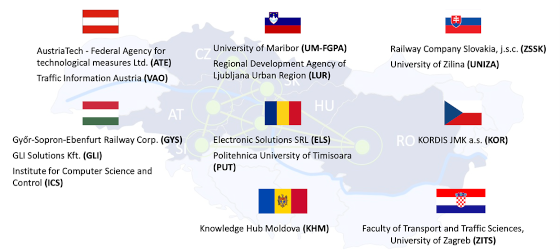
The Project has a good chance to bring the OJP approach one step further by combining public transport with bike information. Furthermore, the project has a chance to highlight the possibilities of the Linking Service concept on a European level, by also making sure to be interoperable with other OJP Initiatives in Europe, such as LinkingAlps and EU Spirit.
Sincerely yours,
Martin Böhm & Katharina Leeb
AustriaTech – Federal Agency for Technological Measures Ltd.
|
|
| |
 |
2. OJP4Danube Project Visual Identity
|
| |
|
The main aim of the OJP4Danube project is to improve coordination mechanisms between transport operators and travel information providers to enable smoother multimodal cross-border journeys. Considering the project objective/s, the following motto was created and approved by project partners:
“Enabling environmentally-friendly journey planning throughout a multimodal Danube Region.”
Project logo, roll-up and a poster were created within the first period.

|
|
| |
 |
3. OJP4Danube Social Media Channels
|
| |
|
The OJP4Danube website serves as a dissemination and communication instrument for the project. The project website is envisaged as the main gateway to the outside world, including key project information.
The project website is hosted by INTERREG DTP platform.
To inform the general public and have even more visibility social media channels on LinkedIn and Facebook were created. Through regular updates, the interested public will stay infrormed.
 https://www.facebook.com/ojp4danube https://www.facebook.com/ojp4danube
 https://www.linkedin.com/groups/9016380/ https://www.linkedin.com/groups/9016380/
|
|
| |
 |
4. Kick-off dissemination event
|
| |
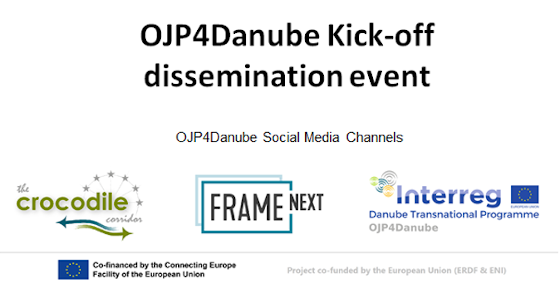 |
| |
|
Next to participating in different events and conferences, wide dissemination of the project and its results are facilitated by 2 public events (Kick-off dissemination event and Final event). The Kick-off dissemination event entitled “Ten years of ITS Directive: Joint technical workshop of CROCODILE 3, FRAME NEXT and OJP4Danube” took place on Tuesday 24, November 2020 – 09:00-13:00 (CET) via Zoom Platform. The three projects have joined forces in order to present their highly innovative plans and achievements to a broad audience.
The diversity of these projects represents a crucial advantage in reaching out to the target groups of OJP4Danube. By addressing the transport community on many different layers and in various professional sub-areas, the Kick-Off Dissemination Event aimed at enlarging the focus of all participants with a strong reference to sustainable and multimodal mobility solutions. By uniting all the different stakeholders, it was possible to raise awareness for the innovative approach of Open Journey Planning while at the same time pointing out its role within the legislative framework that is established by the EU ITS Directive and its supplementing Delegated Regulations.
The objective of the Kick-off dissemination event was to address all future adopters (policy level and operative level ones) outside of the partnership. For this reason, several promotional channels were used to raise the visibility and impact of the Kick-off dissemination event.
The event also got support from EUSDR PA1 to raise the visibility and impact in the form of promoting the event on its social media.
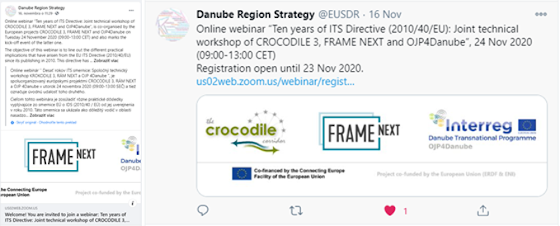
Various stakeholders were approached by project partners, mainly via e-mails, including the invitation for a joint workshop. There were 89 participants who took part in the event: 11 speakers and 2 moderators. Participants represented 13 countries, such as Austria, Croatia, Czech Republic, Germany, France, Great Britain, Greece, Hungary, Italy, Macedonia, Romania, Slovenia, and Slovakia.
Obviously, COVID-19 restrictions prevented the participants from meeting in real setting and exchanging expertise during and after the event itself, however, it proved the professional flexibility of all the members who contributed into the event itself and made it a meaningful and significant starting point for further dissemination events.The speakers demonstrated their high competence in informing the audience about important project-related updates and by this proved the effectiveness of such events in both offline and online environment (despite the milestones of a current pandemic situation worldwide).
|
|
| |
 |
5. First Deliverables and Outputs of WPs
|
| |
 |
| |
|
The Faculty of Transport and Traffic Sciences of the University of Zagreb is especially pleased to participate in the OJP4Danube project. This project fully fits into the mission and vision of the research and development of the ITS Department and the Traffic Planning Department. Part of the activity is carried out in the Laboratory for Data Science in Transport and Logistics. It is important to point out that the content of this project is a continuation of some previous activities on other projects.
The main project activities of the Faculty of Transport and Traffic Sciences are related to preparation Webinar/Academic courses on Open Journey Planners (OJP) technologies for developers as well as the activity related to the acquaintance with the experts in Western Balkan Countries. We contribute to the development of strategy and national action plan for the implementation of OJP. Also, we participate in the definition of the use cases for the pilot services and defining the OJP specification. Finally, we contribute to the implementation of the pilot (evaluation and harmonization).
Our expectations regarding this project are primarily related to the adoption of new and improvement of existing knowledge in the field of development of traffic and travel information services. In addition, our goal is to get acquainted with the experiences of other countries in the expansion and application of services for the provision of traffic and travel information.
We want, after acquiring certain experience alongside this project, to jointly continue the activities in the implementation phase in the Western Balkans, all with the aim of strengthening the competitiveness and sustainability of the multimodal passenger network connecting Central Europe with the Mediterranean.
|
|
 |
|
Prof. Marko Šoštarić, PhD, Vice Dean for Science and External Cooperation, "OJP4Danube project is of great importance for the Faculty of Transport Sciences because it fits perfectly into the research and development strategy of our faculty. In addition, its international approach with countries with which we have a complementary transport network further increases its social justification. We want to strengthen these ties even more, for the general benefit of the economy, tourism and the connection between applied science and higher education."
|
|
|
5.1. OJP4Danube — Project Presentation at the University of Zagreb, Zagreb, Croatia
Within the course Intelligent Transport Systems 1, a presentation about OJP4Danube Project was held on February 25, 2021. The presentation was given virtually, using the Merlin platform (Adobe Connect). There were 62 students: Undergraduate study - (Intelligent Transport Systems) and Master study - (Urban Transport, Road Transport, Logistics). Presenter was Prof. Sadko Mandžuka, PhD.
During the presentation, students were introduced to basic information about the project, its objectives, European Union guidelines for Wide Multimodal Travel Information Services, and the ITS Department role as a project partner. The problem of data availability for multimodal travel planning was especially emphasized. The importance of the Croatian National Access Point urgent implementation for multimodal transportation was pointed out.
In the continuation of the summer semester, in several courses, special lectures are planned for undergraduate and master degree students with topics that are an integral part of the project: Cross-border routing models, Distributed routing systems, Development of user and system requirements, Personalization of route selection decisions, etc. All these lectures will serve as a basis for creating a planned Webinar / Academic course on Open Journey Planning for cross-border multimodal travel based on distributed systems.
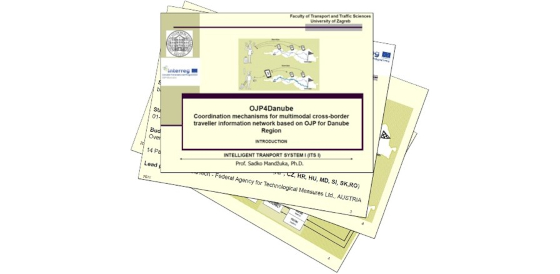
5.2. OJP4Danube — Project Development at the Institute for Computer Science and Control, Budapest, Hungary
ICS is leading the second thematic work package (WP2) where one of the main tasks is to develop the method of the optimized routing across different regions and of the dynamic connection of exchange points. This is a very interesting task because currently journey planners only operate in specific regions, and the multimodal interconnection of these solutions has not been realized yet. Our goal is to define such an innovative method which can connect these journey planners using predefined exchange points. In this way, we can enable travellers with a seamless experience considering several planning parameters and providing the most suitable route options. In order to reach this aim, we have created a workflow of the tasks. Then, we have reviewed similar methods based on the literature. As an intermediate result, we have elaborated the structure of an algorithm to find the most suitable exchange points to connect the journey planners. In addition, we have identified a heuristic algorithm, which can provide a suitable solution for the routing between the exchange points which serve the interconnection of the journey planners.
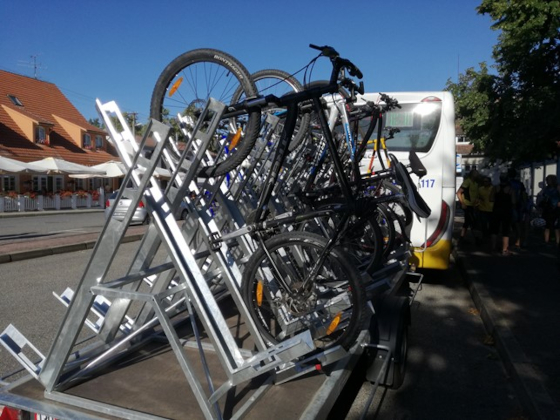
5.3. OJP4Danube — Project Coordination at KORDIS JMK, Brno, Czech Republic
KORDIS JMK as the coordinator of public transport in the South Moravian Region, Czech Republic, is deeply convinced that the differences between regions and people can be solved only by discussion and cooperation. Transportation is the tool which can help to do it. Our region is bordering on two countries and their regions. Therefore, already since the beginning of the integration of public transport in our region in 2004, we have been attempting to establish and develop the cross-border regional public transport connections. We have been successful in this endeavor. At the moment, we provide acceptable cross-border public transport services by trains and buses useful both for commuters and tourists. Thus, our expectations from the project cover primarily the possibility to break the narrow view of national perceptions of public (and eco-friendly) transport connections and bring the new tips for traveling to neighboring areas by public transport, bike, or on foot. Until now, there are still maps on the national level which end at the border. The second reason for our participation in the project is connected to our own ideas and aims in relation to MaaS issues and our effort to resolve all possible transportation gaps in our whole region (not just separate types of transport). We had been participating already in the previous Linking Danube project, which prepared the necessary connections and solutions. The introduction of cross-border journey planner, including eco-friendly types of transport, is the solution which can help people from disadvantaged regions (lying mostly close to the national borders) to move better and smoother way.
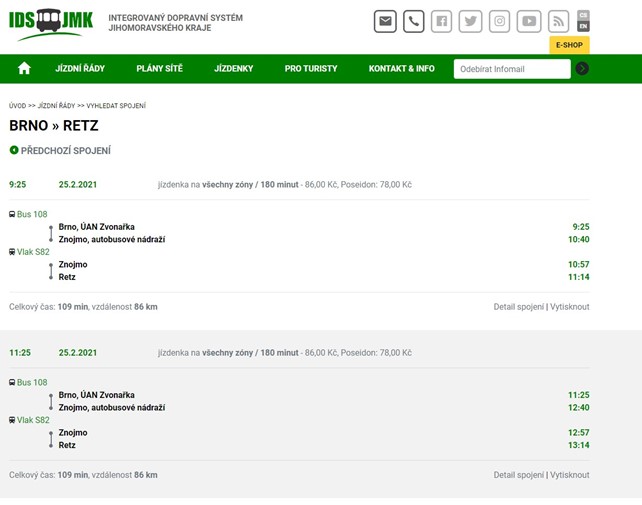
5.4. OJP4Danube — Project Expansion at the University of Maribor, Maribor, Slovenia
|
|
 |
|
The Faculty of Civil Engineering, Transportation Engineering and Architecture at the University of Maribor is devoted to the creation, development, and expansion of knowledge in the fields of civil engineering, architecture, and traffic engineering. The Chair of Construction and Transportation Informatics (KGPI) actively contributes to the development of
|
|
|
EU Standards in public transport (CEN/TC278 WG3 Public Transport), bringing technical competence on data exchange formats. Research activities are focused on building information modelling, knowledge engineering, interoperability for public transport IT systems, automated manufacturing, and innovative e-learning concepts. UM-FGPA is keen on the successful integration of the Slovenian Journey Planner in the coordinated and aligned deployment of the OJP4Danube Open Journey Planning (OJP). As an educational and research institution, UM intends also to share the knowledge obtained through the established transportation engineering educational programmes, enhancing the competencies of future engineers. With experience in national and international research projects, both as a project coordinator and partner, UM intends to continue an active contribution on the technical and organizational areas of the OJP4Danube project. The UM-FGPA is a close cooperation partner of the Ministry of Infrastructure (MIS) operating the travel and traffic information platform in Slovenia, allowing UM-FGPA to bring the national requirements needed for OJP development. UM-FGPA will implement the Slovenian OJP pilot together with LUR and with the support from the Ministry of Infrastructure. As an OJP4Danube Partner, the main contributions to the project are the development of the methodology, the OJP specification and the Pilot implementation. Additionally, UM-FGPA leads the Work Package devoted to the transfer of learnings and support for future adopters, whereas the implementation of an e-learning web tool is one of the main outputs. UM-FGPA distinguishes and recognizes the high level of cooperation and collaboration both internally and within the partnership, especially in a more challenging non-ideal context due to the pandemic.
|
5.5. OJP4Danube — Project Development at the University of Zilina (UNIZA), Zilina, Slovakia
|
|
 |
|
UNIZA with the support of responsible project partners prepared and released two major reports within the timeline of the first six months of the project, namely: ‘ex-ante analysis’ (D.T1.1.1) and ‘use-cases’ (D.T2.1.1).
The first on ‘ex-ante analysis’ (D.T1.1.1) is a review of the current solutions offered by the six transport information service providers (TISPs) participating in the OJP4Danube consortium. The review focused on journey planner features enabling the integration of
|
|
|
eco-friendly transport modes with public transport journey planning. The interviews based on a questionnaire were also conducted to score each feature desirability and assess their priority for potential future implementation. A typology of ‘multimodal journey planner maturity level’ was produced as a high-level guidance for prioritizing features (see both D.T1.1.1 section 3.3 and D.T2.1.1 section 2.6):
1) support for multimodal routing: ability to generate door-to-door routes across all modes, including first- and last-mile as well as basic travel data such as distances;
2) support for mode-specific and intermodal comfort: features and search options relevant for improving the travel experience for eco-friendly modes, including connectivity at public transport interchanges;
3) additional optional features, which can improve the overall trip experience from a traveller perspective.
Top features to consider included the integration of first- and last- mile walking or cycling distance to public transport stops, where taking an eco-friendly mode onboard public transport is permitted and the integration of cycling routes in local journey planners is realised where relevant.
The second report on ‘use-cases’ (D.T2.1.1) was designed to test the implementation of the desired features on various arrangements of typical cross-border trips for commuting and tourism.
Next steps will require to define common user interface and data exchange requirements for implementation by TISPs to demonstrate basic cross-border functionalities with focus on bicycle and train integration.
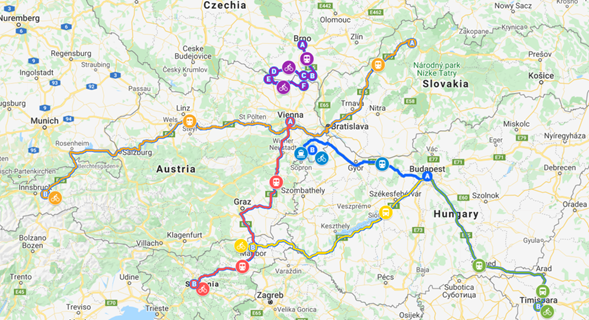
5.6. OJP4Danube — Project Integration in the Work of Railways of the Slovak Republic (ZSSK)
|
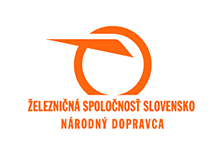 |
|
Railways of the Slovak Republic (ZSSK) is the largest passenger railway carrier in Slovakia - it operates more than 1,500 trains a day. Our goal is to ensure comfortable travelling by ecological railway transport for as many passengers as possible. That is why we are participating in the European project
|
|
|
OJP4Danube - a project that connects the countries around the Danube and seeks to offer passengers access to a cross-border route planner integrating different modes of transport. One of the modes of transport is the use of private or shared bicycles on the first or last mile of the route. To plan the transporting of bicycles, it is necessary to have information on the transport capacity and occupancy of special areas designated for this purpose in the wagons. Equally important is the information on the possibility of renting shared bicycles at individual stops or ensuring the mediation of the use of these services at their providers. Our aim is to satisfy our passengers as much as possible, and this can be achieved, among other things, by providing timely and comprehensive information. The OJP4Danube project is one of the tools that we truly believe will help us to do this.


|
|
|
|
| |
|
If you have received this newsletter, you have been included on one or more of the Danube Transnational Programme/projects postal mailing lists. We are committed to respect and protect the privacy of personal data collected. We regard your personal data as confidential information and will never communicate it to third parties. Your personal data are used mainly for the express purpose of receiving the newsletter. Your mailing details may also be used by the DTP and its projects for information and dissemination purposes strictly related to the programme and its projects. If you prefer not to receive more of this newsletter and your data not to be used for dissemination purposes, you can unsubscribe by sending a reply email.
|
|
|
|
|
|
